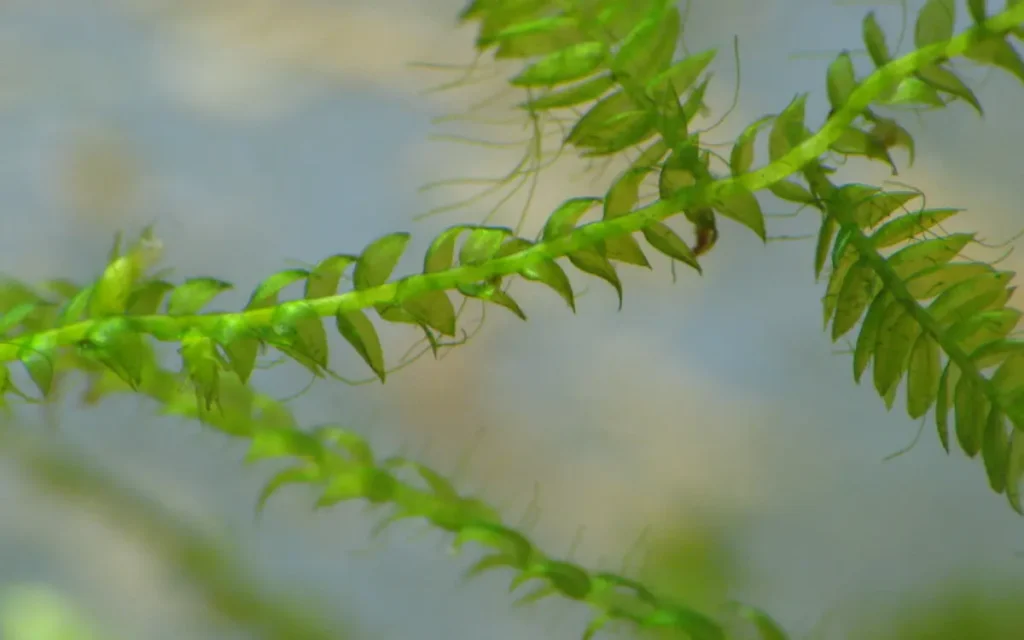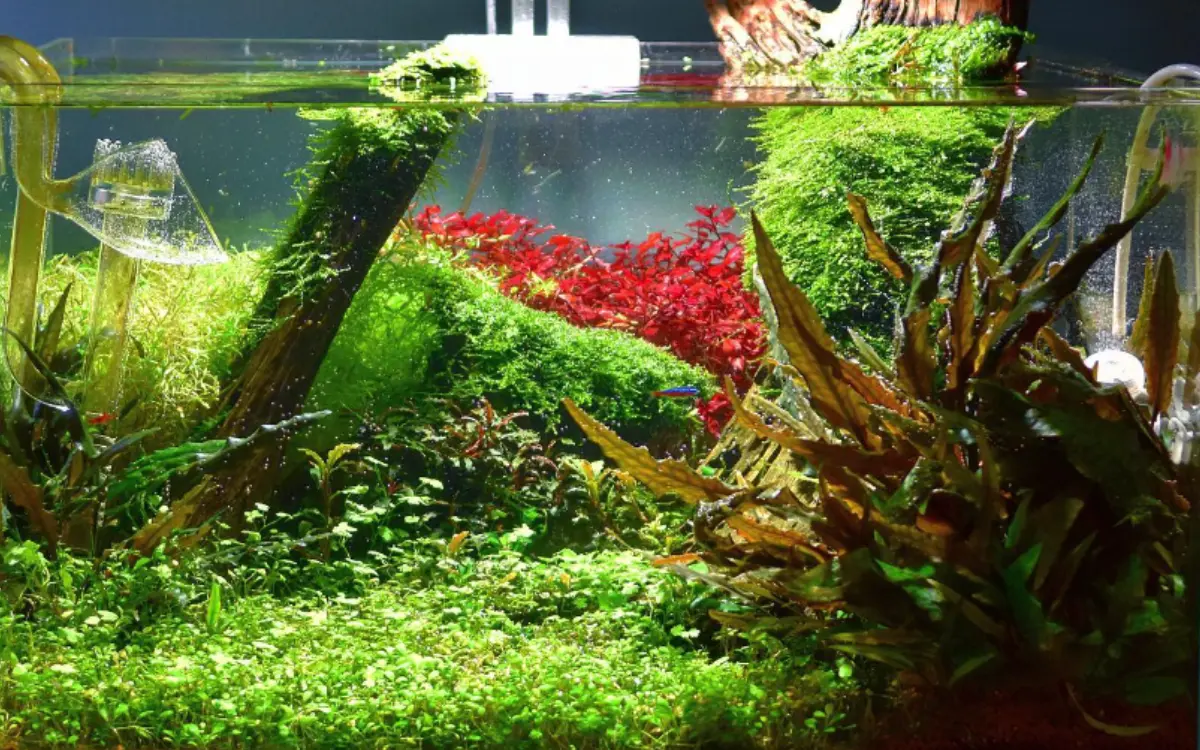Carpet plants are perfect for making your aquarium look lush and beautiful. They spread across the tank floor, creating a green carpet.
Here are the top 10 easy-to-care-for carpet plants for beginners.
Top 10 Carpet Plants for Beginners
1.Java Moss (Taxiphyllum barbieri)

Java Moss is a popular carpet plant for beginners. It’s easy to grow and care for, forming a dense, green carpet in your aquarium. Ideal for low-maintenance tanks, it adds a natural, lush look.
Ideal Conditions:
- Light: Low to moderate.
- Temperature: 59-86°F (15-30°C).
- pH: 5.0-8.0.
Planting and Care Tips:
- Attach to rocks or driftwood.
- Trim regularly to maintain shape.
- Requires little to no special care.
2.Dwarf Hairgrass (Eleocharis parvula)
Dwarf Hairgrass is a favorite among beginners for creating a soft, grassy carpet in aquariums. Its fine, bright green blades spread quickly, providing a natural and appealing look to your tank.
Ideal Conditions:
- Light: Moderate to high.
- Temperature: 50-85°F (10-29°C).
- pH: 6.5-7.5.
Planting and Care Tips:
- Plant in small clumps for quicker spread.
- Use nutrient-rich substrate.
- Trim regularly to maintain height.
- Ensure good lighting to promote growth.
3.Marsilea Minuta
Marsilea Minuta, also known as dwarf water clover, is a small, clover-like plant that forms a dense carpet. It’s easy to care for and perfect for adding a natural look to aquariums.
Ideal Conditions:
- Light: Low to moderate.
- Temperature: 68-82°F (20-28°C).
- pH: 6.0-7.5.
Planting and Care Tips:
- Plant in small patches for faster coverage.
- Use nutrient-rich substrate.
- Trim regularly to prevent overgrowth.
- Requires occasional fertilization for best growth.
4.Monte Carlo (Micranthemum tweediei)
Monte Carlo is a small, bright green plant that forms a lush carpet in aquariums. It’s popular for its ease of growth and ability to create a beautiful, natural-looking floor.
Ideal Conditions:
- Light: Moderate to high.
- Temperature: 68-77°F (20-25°C).
- pH: 6.0-7.5.
Planting and Care Tips:
- Plant in small clusters for quicker spread.
- Use nutrient-rich substrate.
- Trim regularly to maintain desired height.
- Benefits from CO2 injection for optimal growth.
Read also:-
5.Dwarf Baby Tears (Hemianthus callitrichoides)
Dwarf Baby Tears, also known as HC, is a tiny, bright green plant that forms a dense, carpet-like mat. It’s popular for its delicate appearance and ability to cover the substrate beautifully.
Ideal Conditions:
- Light: High.
- Temperature: 68-82°F (20-28°C).
- pH: 5.0-7.5.
Planting and Care Tips:
- Plant in small patches for faster coverage.
- Use fine-grain, nutrient-rich substrate.
- Trim regularly to prevent overgrowth.
- CO2 injection and regular fertilization enhance growth.
6.Sagittaria Subulata (Dwarf Sagittaria)
Dwarf Sagittaria is a hardy, grass-like plant that forms a thick, green carpet. It’s known for its ease of care and ability to thrive in various conditions, making it ideal for beginners.
Ideal Conditions:
- Light: Low to moderate.
- Temperature: 68-82°F (20-28°C).
- pH: 6.5-8.0.
Planting and Care Tips:
- Plant in small clumps for quicker spread.
- Use nutrient-rich substrate.
- Trim regularly to control height and spread.
- Tolerates a range of water conditions, making it low-maintenance.
7.Staurogyne Repens
Staurogyne Repens is a compact, green plant with sturdy leaves that create a lush, low-growing carpet. It’s popular for its easy care and versatility in aquascaping, making it great for beginners.
Ideal Conditions:
- Light: Moderate to high.
- Temperature: 68-82°F (20-28°C).
- pH: 6.0-7.5.
Planting and Care Tips:
- Plant in small groups for faster spreading.
- Use a nutrient-rich substrate.
- Trim regularly to encourage dense growth.
- Benefits from CO2 injection and regular fertilization for optimal health.
8.Lilaeopsis Brasiliensis (Micro Sword)
Lilaeopsis Brasiliensis, commonly known as Micro Sword, is a low-growing plant with narrow, grass-like leaves. It forms a dense, green carpet that adds a natural look to aquariums and is relatively easy to care for.
Ideal Conditions:
- Light: Moderate to high.
- Temperature: 70-83°F (21-28°C).
- pH: 6.5-7.5.
Planting and Care Tips:
- Plant in small clumps to encourage spreading.
- Use nutrient-rich substrate.
- Trim regularly to maintain desired height and prevent overgrowth.
- Benefits from CO2 injection and regular fertilization for best results.
9.Cryptocoryne Parva
Cryptocoryne Parva is the smallest species of Cryptocoryne, featuring small, green leaves that form a compact, dense carpet. It’s slow-growing but very hardy, making it an excellent choice for beginners.
Ideal Conditions:
- Light: Low to moderate.
- Temperature: 68-82°F (20-28°C).
- pH: 6.0-7.5.
Planting and Care Tips:
- Plant in small groups for better coverage.
- Use a nutrient-rich substrate.
- Trim sparingly, as it grows slowly.
- Tolerates low light and minimal CO2, making it low-maintenance.
10.Pygmy Chain Sword (Echinodorus tenellus)
Pygmy Chain Sword is a small, grass-like plant that forms a dense, green carpet in aquariums. It is known for its fast growth and ability to spread quickly, making it a favorite for beginners.
Ideal Conditions:
- Light: Moderate to high.
- Temperature: 68-82°F (20-28°C).
- pH: 6.5-7.5.
Planting and Care Tips:
- Plant in small clumps to encourage spreading.
- Use nutrient-rich substrate.
- Trim regularly to control height and prevent overgrowth.
- Benefits from CO2 injection and regular fertilization for optimal growth.
FAQ
How long does it take for carpet plants to grow?
Carpet plants typically take 2-4 weeks to start establishing and spreading, but full carpet coverage may take a few months, depending on the plant species and tank conditions.
Can carpet plants grow without CO2 injection?
Yes, many carpet plants can grow without CO2 injection, though growth may be slower and less dense. CO2 injection enhances growth and helps plants thrive.
What is the best substrate for carpet plants?
Nutrient-rich substrates like aqua soil or plant-specific substrates are best for carpet plants. These substrates provide essential nutrients and promote healthy root development.
How often should I fertilize my carpet plants?
Fertilize carpet plants weekly with liquid fertilizers and use root tabs every 1-2 months. This ensures they receive the necessary nutrients for optimal growth.
Do carpet plants need a lot of light?
Most carpet plants require moderate to high light to grow well. Adequate lighting promotes healthy growth and helps maintain their vibrant green color.

